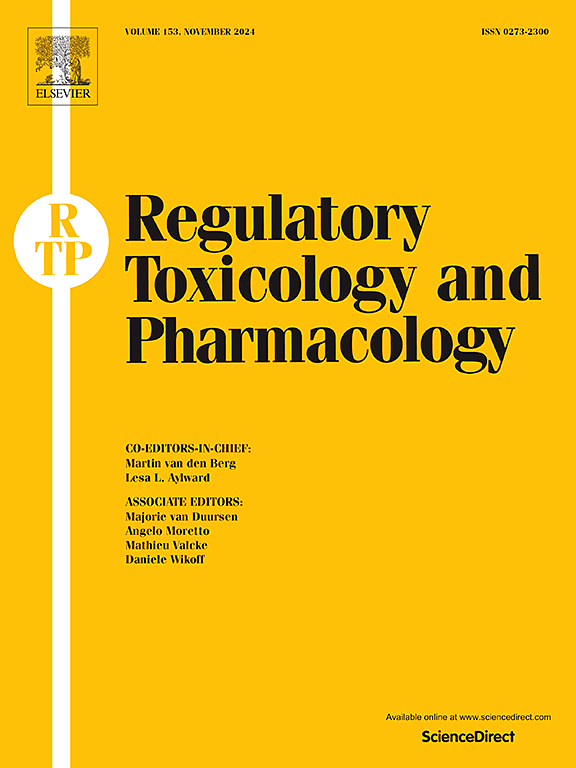用腹膜内途径进行体内微核试验评价染发剂遗传毒性的适宜性
IF 3.5
4区 医学
Q1 MEDICINE, LEGAL
引用次数: 0
摘要
化妆品不能产生新的体内数据。新的遗传毒性安全评估必须依赖于禁令颁布前的哺乳动物红细胞微核(MN)试验的体内数据。许多人使用腹腔(i.p)给药,没有科学依据不再推荐。因此,我们调查了这些研究是否仍然有效,以评估染发剂的遗传毒性。小到中等大小的分子,包括染发剂,优先通过门静脉吸收并进行第一次代谢,而大分子则由淋巴管直接进入体循环。服药后小分子血药浓度通常与服药后相似,甚至更高。重要的是,使用ip和po途径进行体内MN测试的结果是相同的。大多数遗传毒性致癌物在体内MN试验中呈阳性结果,通过i.p.注射给药。不同给药途径的体内遗传毒性测定结果的差异归因于作用方式和/或组织特异性效应。总之,ip途径达到足够高的内部暴露,即血浆和骨髓。因此,使用ip路线的传统OECD测试指南符合研究对当前染发剂的安全性评估是有效的。本文章由计算机程序翻译,如有差异,请以英文原文为准。
Suitability of the use of the intraperitoneal route in the in vivo micronucleus test to evaluate the genotoxicity of hair dyes
New in vivo data cannot be generated for cosmetics. New safety assessments for genotoxicity must rely on in vivo data from the in vivo Mammalian Erythrocyte Micronucleus (MN) Test generated before the ban. Many used intraperitoneal (i.p.) administration, which is no longer recommended without scientific justification. Therefore, we investigated whether these studies are still valid for evaluating genotoxicity of hair dyes. Small to medium size molecules, including hair dyes, are preferentially absorbed via the portal vein and undergo first-pass metabolism, whereas large molecules are taken up by the lymphatics directly into the systemic circulation. Plasma concentrations of small molecules are generally similar, if not higher, after i.p. than after p.o. administration. Importantly, outcomes from in vivo MN Test using the i.p. and p.o. routes were equivalent. Most genotoxic carcinogens with positive outcomes in the in vivo MN Test were administered by i.p. injection. Differences between in vivo genotoxicity assay results using administration routes are attributed to the Mode of Action and/or tissue-specific effects. In conclusion, the i.p. route achieves sufficiently high internal exposure i.e., in the plasma and bone marrow. Therefore, legacy OECD test guideline compliant studies using the i.p. route are valid for current safety assessments of hair dyes.
求助全文
通过发布文献求助,成功后即可免费获取论文全文。
去求助
来源期刊
CiteScore
6.70
自引率
8.80%
发文量
147
审稿时长
58 days
期刊介绍:
Regulatory Toxicology and Pharmacology publishes peer reviewed articles that involve the generation, evaluation, and interpretation of experimental animal and human data that are of direct importance and relevance for regulatory authorities with respect to toxicological and pharmacological regulations in society. All peer-reviewed articles that are published should be devoted to improve the protection of human health and environment. Reviews and discussions are welcomed that address legal and/or regulatory decisions with respect to risk assessment and management of toxicological and pharmacological compounds on a scientific basis. It addresses an international readership of scientists, risk assessors and managers, and other professionals active in the field of human and environmental health.
Types of peer-reviewed articles published:
-Original research articles of relevance for regulatory aspects covering aspects including, but not limited to:
1.Factors influencing human sensitivity
2.Exposure science related to risk assessment
3.Alternative toxicological test methods
4.Frameworks for evaluation and integration of data in regulatory evaluations
5.Harmonization across regulatory agencies
6.Read-across methods and evaluations
-Contemporary Reviews on policy related Research issues
-Letters to the Editor
-Guest Editorials (by Invitation)

 求助内容:
求助内容: 应助结果提醒方式:
应助结果提醒方式:


